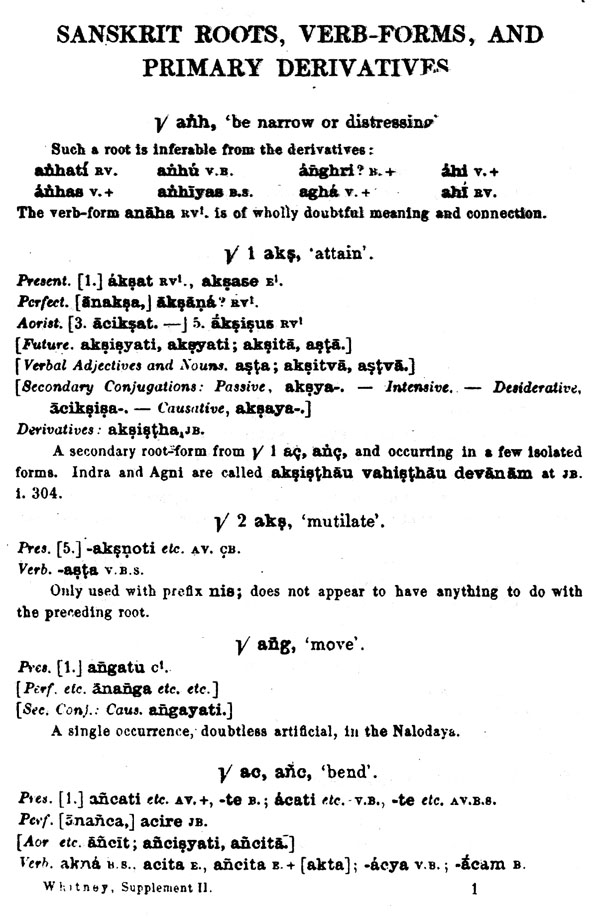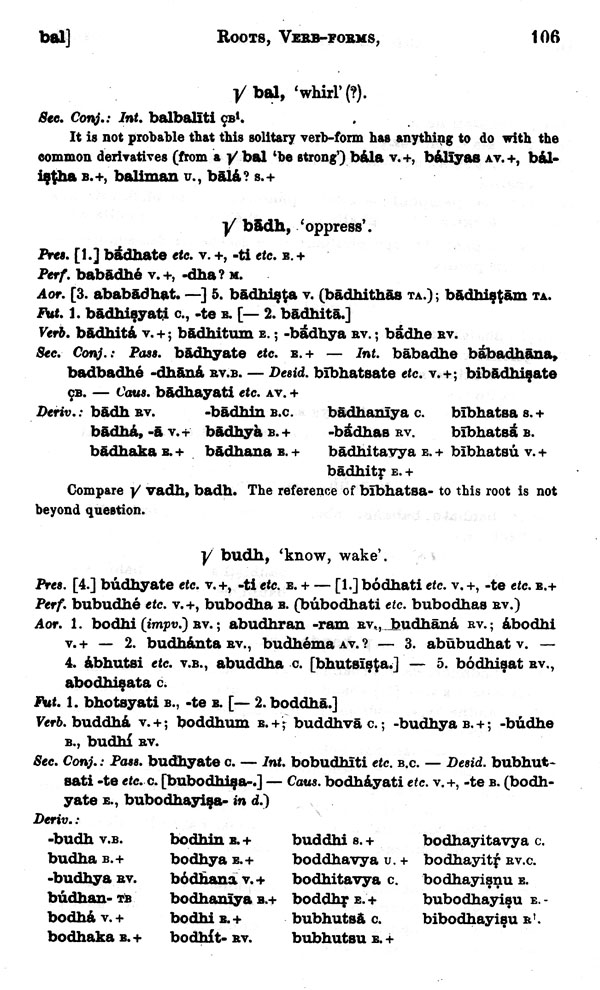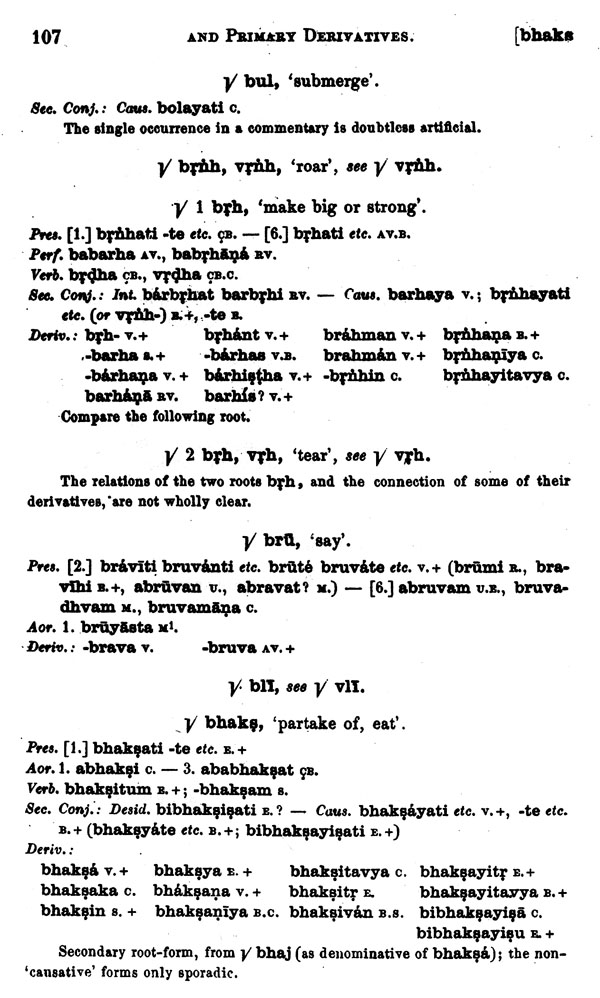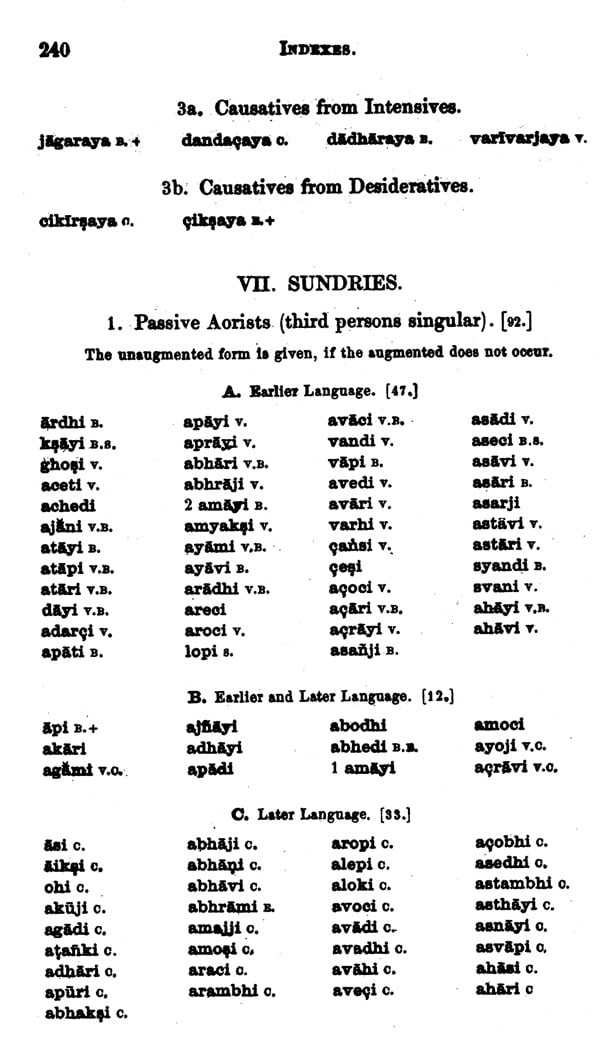
The Roots, Verb-Forms and Primary Derivatives of The Sanskrit Language (An old Book)
Book Specification
| Item Code: | NAZ445 |
| Author: | William Dwight Whitney |
| Publisher: | Bharatiya Granth Niketan |
| Language: | English |
| Edition: | 2004 |
| ISBN: | 9788189211035 |
| Pages: | 250 |
| Cover: | HARDCOVER |
| Other Details | 9.00 X 6.00 inch |
| Weight | 410 gm |
Book Description
This work is intended especially as a Supplement to my Sanskrit Grammar (Leipzig, 1879), giving, with a ful- ness of detail that was not then practicable, nor admissible as part of the grammar itself, all the quotable roots of the language, with the tense and conjugation-systems made from them, and with the noun and adjective (infinitival and par- ticipial) formations that attach *themselves most closely to the verb; and further, with the other derivative noun and adjective-stems usually classed as primary: since these also are needed, if one would have a comprehensive view of the value of a given root in the language. And everything given is dated, with such accuracy as the information thus far in hand allows — whether found in the language throughout its whole history, or limited to a certain period.
My leading authority has necessarily been that magni- ficent thesaurus of authentic information respecting the Sanskrit language of every period, the great St. Peters- burg Lexicon of Béhtlingk and Roth.! This I have gone carefully over, excerpting all the material needed for my purpose. So far, indeed, as concerns the epic and clas- sical literature, the Lexicon has been almost my sole source, since my own collections, for verification or of additional material, though not wholly wanting, have yet been al- together insignificant as compared with it. But in the older language, of Veda and Brahmana and Upanishad and Sutra, I have done much more independent work. I have, namely, gone over all the texts of the earlier period accessible to me, including (by the kindness of Professor Weber) the as yet unpublished Kausitaki-Brahmana and Kathaka, and ‘by the kindness of the late Dr. Burnell) the immense Jaiminiya or Talavakara-Brahmana, which has as yet hardly been accessible to any one else;! and from them I have ex- cerpted all the noteworthy verbal forms and (less completely) the primary derivatives; thus verifying and occasionally correcting the material of the Lexicon, supplying chance omissions, and especially filling in not a few details which it had not lain in the design of that work to present in their entirety.
As a matter of course, no such work as the present can pretend to completeness, especially at its first appearance. The only important texts of which we have exhaustive verbal indexes are the Rig-Veda and the Atharva-Veda, nor is it known that any other is in preparation; and only where such indexes exist can the inclusion of all that a text contains be assured. But I trust it will be found that the measure of completeness here attained is in general proportioned to the importance of the material: that it is the more indifferent forms and derivatives which, having been passed over by the Lexicon, have escaped my glean- ing also. { expect to continue the work of verification and addition, and to make an eventual future edition perceptibly nearer to perfection in its details, and possessing such im- provements in plan as my own experience and the criticisms of others may suggest. It is unnecessary to add that corrections and additions of any kind will be welcomed by me, and duly acknowledged.
Of the verb-forms which, though not yet found — and. for the most part, destined never to be found — in recorded use, are prescribed or authorized by the Hindu grammarians, a liberal presentation is made under the different roots: such material being always distinguished from the other by being put in square brackets. It is in no part given at first hand, but only as reported by Western authorities: the Lexicon, Westergaard’s Radices, and the various Euro- pean grammars; all of these supplement rather than con- tradict one another; and any occasional disagreement among them is passed over, as relating to a matter of too little consequence to be worth reporting.
The periods in the life of the language which are acknowledged and distinguished by appropriate notation are six: the Veda (marked with v.), the Brahmana (with B.), the earlier or more genuine Upanishads (with v.), the Sutras (with s.), the epics, Mahabharata and Ramayana (with &.), and the classical or common Sanskrit (with c.). This classification, however, is by no means an absolute one, and calls for certain explanations and limitations, as follows.
Book's Contents and Sample Pages











